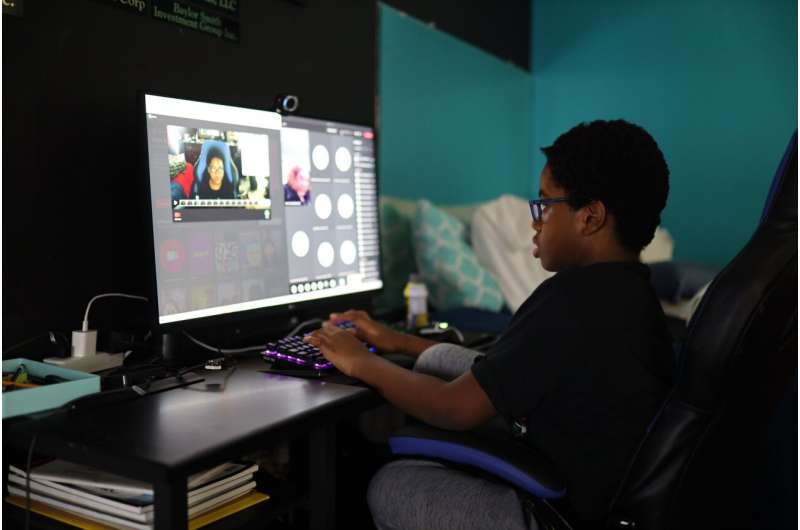This article has been reviewed according to Science X's editorial process and policies. Editors have highlighted the following attributes while ensuring the content's credibility:
fact-checked
trusted source
proofread
Dialog beyond spoken words important in teaching-learning situations, even digitally

Even in digital courses, it's not just the spoken word that counts. Aspects such as tone of voice, eye contact and the appreciation experienced are also important, as a study by the University of Würzburg shows.
With the pandemic came its big boom: Digital teaching events. Depending on the incidence and the respective regulations, lecturers and students met purely digitally in specially set up Zoom meetings. Alternatively, some of the students sat at a safe distance in the lecture hall, while the rest followed the proceedings on their PCs in their home study.
A team from the Institute of Education at the Julius-Maximilians-Universität Würzburg (JMU) used the example of two seminars in the summer semester of 2023 to investigate how these different settings affect teaching and learning. Regina Egetenmeyer, Professor for Adult and Continuing Education at JMU, and Ramon Flecha, sociologist, Professor Emeritus at the University of Barcelona and at that time Visiting Professor at the Institute of Education, were responsible for the study. The researchers have now published the results of their research in the Multidisciplinary Journal of Educational Research.
Dialogic teaching works even in synchronous-hybrid teaching settings
"The study shows that it is highly relevant to think about dialogue in teaching-learning situations beyond spoken words. It is therefore the task of teachers to observe learners and to design appreciative dialogs in teaching-learning settings beyond spoken words," Egetenmeyer summarizes the central result of her study. The two seminars in the summer semester of 2023 showed that this is also possible in events in which some of the students are present on site and some are connected via computer.
In fact, the study shows that dialogic teaching has a positive effect on students even in synchronous-hybrid teaching settings—whereby it is not only the words spoken that matter, but also the tone of voice, eye contact and the appreciation experienced. "The evaluation shows that students see dialogue as very positive for their learning process. In some cases, they even see a transformative potential of dialogue with regard to their personality development," says Egetenmeyer.
Looking at speech acts alone is not enough
"In the recent past, scholars have been intensively studying issues around dialogic teaching in face-to-face as well as online and hybrid sessions," says Professor Ramon Flecha, explaining the background of the study. However, in his view, most analyses of dialogic teaching are reduced to an identification of dialogue with words, with so-called speech acts. Yet, he says, it has long been clear that looking at speech acts alone is not enough to capture a dialogue, because speech acts do not take into account central dimensions of human relationships.
"That's why new theoretical developments are now taking the place of the traditional ones. One of them is the move from speech acts to communicative acts," says Professor Marta Soler of the University of Barcelona, who is co-author of the paper. These are characterized by the fact that communication takes place not only through words, but also through other signs such as looks, voice pitch and body language. Accordingly, it is possible to develop dialogic teaching beyond words. So far, however, there have been no empirical studies based on this theoretical approach. The study now published by the Spanish-German team is thus the first in this field.
Positive verdicts from students
Two seminars of a university master's program at JMU were the focus of the research. Participation in them was possible both in presence and digitally. In the synchronous-hybrid seminars, students were provided with accompanying materials; there they could also give anonymous feedback on the individual events. In parallel, the research team closely monitored all forms of communication related to the seminars and created a documentary analysis of all feedback written by students at the end of each session.
"Our evaluations show that the students consistently rated this form of dialogic teaching, which is based on communicative actions beyond speech acts, positively," says Ane López de Aguileta from the University of Barcelona, who was also a visiting researcher at the University of Würzburg during the summer semester. On the one hand, the seminar participants were extremely satisfied with their own learning success. On the other hand, they were of the opinion that they would be able to use this method to initiate changes in their later professional lives, for example in educational projects.
Based on this study, Egetenmeyer and Flecha now want to investigate other teaching-learning settings at the University of Würzburg with regard to their significance of "Dialogic Teaching beyond Words" in order to expand knowledge of the innovative teaching potential.
More information: Mar Joanpere Foraster et al, Dialogic teaching beyond words, Multidisciplinary Journal of Educational Research (2023). DOI: 10.17583/remie.12867
Provided by Julius-Maximilians-Universität Würzburg





















